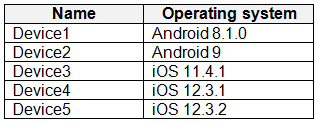You have a Microsoft Intune subscription.
You have devices enrolled in Intune as shown in the following table.

An app named App1 is installed on each device.
What is the minimum number of app configuration policies required to manage App1?
You have a Microsoft Intune subscription.
You have devices enrolled in Intune as shown in the following table.

An app named App1 is installed on each device.
What is the minimum number of app configuration policies required to manage App1?
To manage App1 on the listed devices, you need separate app configuration policies for each platform, regardless of the specific versions of their operating systems. In this case, you have devices running Android (versions 8.1.0 and 9) and devices running iOS (versions 11.4.1, 12.3.1, and 12.3.2). Therefore, you need one app configuration policy for Android devices and one for iOS devices. This totals to a minimum of two app configuration policies.
answer B is correct You need app protection for both platforms, separately
Correct, although the answer remains the same, the question is about app configuration policies, not app protection policies :-)
Technically it is possible to create one app configuration policy for both IOS and Android; when I go to the 'basics' tab, then set 'target policy to' to 'selected apps' and then 'select public apps', I can select the same app for Android and iOS/iPadOS at the same time. The question doesn't mention any other requirements regarding different settings or to do it using best practices. So from what technically is possible and the given (or lacking) requirements in the question, I would say you can achieve it with one App Configuration Policy. Thus I vote A. If someone can clearly explain to me why I need 2 such policies, as that is the most voted answer, please let me know. The current present explanations are not conclusive enough for me.
I agree, right answer is A.1. I dont see any reason why need to create two separate policies. On basic tab you can choose selected apps, all apps, all microsoft apps or core microsoft apps.
We were wrong, right answer is 2.
We were wrong, right answer is 2.
To manage App1 on the listed devices, you need to create app configuration policies for each platform, not for each version of the operating system. In this case, you have: Android: Device1 and Device2 (Android 8.1 and Android 9) iOS: Device3, Device4, and Device5 (iOS 11.4.1, iOS 12.3.1, and iOS 12.3.2) You need one app configuration policy for Android and one for iOS. Therefore, the minimum number of app configuration policies required is: B. 2
You need seperate policies for each OS.
If you create an APP CONFIGURATION -> MANAGED APPS and in the "selected apps" add the two versions of App1 (android and iOS) you could configure the same App with 1 policy so answer "A". In case of MANAGED DEVICES instead you have to choose iOS or Android and in that case is "B". As usually Microsoft is misleading with the exam questions, assuming that the less is better, I will go with "A"
YouTube shows you need to choose the Platform first before picking the app. Only one platform can be picked at a time. Thus 2 policies are required.
assuming that it's possible to add IOS and Android Apps in the same configuration under "selecting public apps " or "selectied custom apps"
Correct ans is B For iOS and for Android.
in this scenario, the minimum number of app configuration policies required is 2 : one for Android devices and one for iOS devices. This assumes that the configuration settings for App1 are the same within each platform.
B. one app configuration policy for each platforms
Again this is debatable, devices are enrolled so one can presume you will select "managed devices", there you have to chose a platform. With choosing Managed Apps, the policy doesn't care if the devices are enrolled or not, if you select all apps or individual apps, the target will be both platforms together so 1 policy. In this case I place my bet on B
It's B
Intune represents these different app configuration policy channels as: Managed devices. The device is managed by Intune as the unified endpoint management provider. Managed apps. An app that has either integrated the Intune App SDK or have been wrapped using the Intune Wrapping Tool and supports App Protection Policies (APP). In this scenario (devices enrolled in Intune): Choose the Apps - App configuration policies - Add - Managed devices On basic tab: Select platform iOS/iPad or Android https://learn.microsoft.com/en-us/mem/intune/apps/app-configuration-policies-overview https://learn.microsoft.com/en-us/mem/intune/apps/app-configuration-policies-use-ios https://learn.microsoft.com/en-us/mem/intune/apps/app-configuration-policies-use-android
The correct answer is B because you need to create two app configuration policies for managed devices, one for iOS/iPadOS devices and one for Android devices1. App configuration policies let you customize the settings of apps for iOS/iPadOS or Android devices1. The settings are assigned to user groups and applied when the app runs1. The app developer or supplier provides the configuration settings (keys and values) that are exposed to Intune1. You can’t use a single app configuration policy for both iOS/iPadOS and Android devices because they have different configuration settings2. Reference: 1: App configuration policies for Microsoft Intune | Microsoft Learn https://learn.microsoft.com/en-us/mem/intune/apps/app-configuration-policies-overview 2: Add app configuration policies for managed iOS/iPadOS devices | Microsoft Learn https://learn.microsoft.com/en-us/mem/intune/apps/app-configuration-policies-use-ios
The correct answer is B. Based on testing in my tenant, each platform requires its own dedicated policy.
B is correct